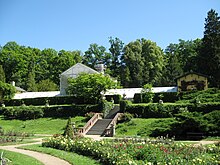Konopiště rose garden
The Konopiště rose garden (also Rosarium Konopiště) was laid out between 1906 and 1913 in the former baroque garden of Konopiště Castle 40 kilometers south-east of Prague on behalf of Franz Ferdinand of Austria-Este and his wife Sophie Duchess von Hohenberg . After an eventful history, the formal rose garden is now the center of the Konopiště Landscape Park .
History of the rose garden
Gardens were laid out in the vicinity of Konopiště Castle as early as the 18th century. After Franz Ferdinand von Österreich-Este had acquired the castle and the lands in 1887, a comprehensive redesign of the buildings and expansion of the park began. First, some farm buildings in the immediate vicinity of the castle, including a brewery and distillery, various barns and a sugar factory, were demolished to make room for the new park and gardens. After the castle was rebuilt in the years 1889 to 1894 according to plans by Josef Mocker , the redesign of the 225 hectares enlarged grounds to a landscape park began.
As early as 1888, the first plans for a rose garden southeast of the palace on the site of the old baroque garden were submitted. After the suicide of Crown Prince Rudolf in Mayerling in 1889 and the death of Karl Ludwig of Austria , Franz Ferdinand became heir to the Austro-Hungarian throne in 1896 under the Habsburg house laws. In 1900 he morganatically married Sophie Chotek von Chotkova and then largely withdrew from the Viennese court . Konopiště Castle was expanded and became the permanent residence of the family. The gardens and the landscape park were redesigned and gradually laid out. However, work on the garden according to plans by the imperial court gardener Karl Mösmer from Vienna and the head gardener Karel Rozínek from Prague did not begin until 1906, as the terrace garden above had to be redesigned in the immediate vicinity of the palace. The plants and roses for the garden were delivered from Austria-Hungary and Thuringia to the nurseries and tree nurseries in Konopiště.
In addition to 1,500 standard roses, the gardeners also planted 7,000 shrub roses in the rose ground floor. The formal rose garden was decorated with numerous sculptures and stone vases from the Castello del Catajo (near Padua ), some of which Archduke Franz Ferdinand had inherited and supplemented with his own acquisitions. In the center of the garden is a nine-meter-high Cleopatra column, which is accompanied by four obelisks . Above the rose garden, a 1,200 square meter greenhouse for palm trees and orchids was built on a higher terrace . In addition to wisteria , yellow climbing roses 'Marechal Niel', which Sophie von Hohenberg received as a gift, were also planted on the greenhouse .
The rose garden was completed in 1913. In the French-style rose garden, 200 different types of roses were planted on an area of five hectares. The visual finish of the rose garden was formed by a pond planned by the English landscape architect Ernest Marchan with an alpine plant and a rustic cork arbor, which were also completed in 1913. In 1913 and in June 1914, just before Franz Ferdinand and his wife were murdered in Sarajevo , Kaiser Wilhelm II visited Konopiště Castle, the rose garden and the cork arbor.
In 1921 the Konopiště Castle and Park were nationalized and became the property of the Ministry of Agriculture of the Czechoslovak State . The park and partly also the castle were opened to the public. During the Second World War one was on the premises SS - Headquarters . The rose garden was badly damaged by acts of war in the last months of the war. After the Second World War, the garden was opened to visitors again, but the plant population was gradually neglected. The rosarium was redesigned and replanted in 1962 by Bohumil Kavka and Milada Opatrná. A comprehensive renovation, including the reconstruction of the greenhouse, which has not been accessible since the 1970s, took place between 1995 and 2000. Today there are around 5200 rose plants in the rosarium.
Individual evidence
- ↑ a b c d e Konopiště - zámecký park a Růžová zahrada. March 19, 2009, Retrieved April 4, 2020 (Czech).
- ^ A b c Alena Skrabanek: Castle and Park in Konopischt in the Czech Republic . In: Ilsebill Barta, Marlene Ott-Wodni, Alena Skrabanek (eds.): Representation and (without) power: The living culture of the Habsburg princes in the 19th century - Emperor Maximilian of Mexico, Crown Prince Rudolf, Archduke Franz Ferdinand and their castles. tape 38 . Vandenhoeck & Ruprecht, Göttingen 2019, ISBN 978-3-205-20036-9 , pp. 255 ff .
- ↑ a b list of artists and suppliers . In: Ilsebill Barta, Marlene Ott-Wodni, Alena Skrabanek (eds.): Representation and (without) power: The living culture of the Habsburg princes in the 19th century - Emperor Maximilian of Mexico, Crown Prince Rudolf, Archduke Franz Ferdinand and their castles. tape 38 . Vandenhoeck & Ruprecht, Göttingen 2019, ISBN 978-3-205-20036-9 , pp. 701 .
- ↑ Růžová zahrada a Skleník na Konopisti. Retrieved April 5, 2020 (Czech).
- ^ Franz Ferdinand's family residence. Retrieved April 4, 2020 .
- ^ Konopiště. Retrieved April 4, 2020 (Czech).
- ^ Růžová zahrada: Zámecký park Konopiště. Retrieved April 4, 2020 .
Web links
Coordinates: 49 ° 46 ′ 39.4 " N , 14 ° 39 ′ 29.1" E


